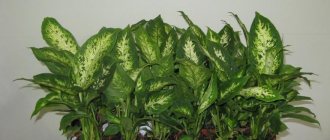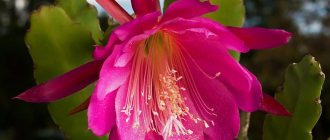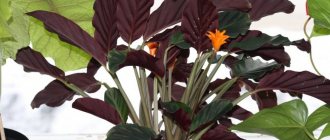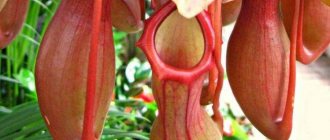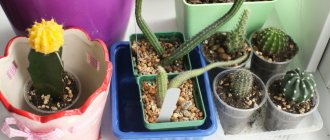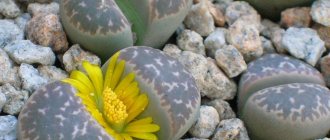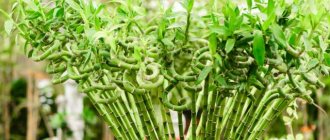Aglaonema: care without problems? Anyone who doesn’t like aglaonemas is simply not familiar with them. Unpretentious and decorative, they color our everyday life with bright pink, red, green and golden colors, and at the same time perfectly purify the indoor air. We have to take it, guys, we have to take it!
What place in the house to choose for aglaonema
What place to choose at home for Aglaonema
Aglaonema will decorate any living space. It remains decorative all year round, its flowers are odorless, and its leaves purify the air from benzene, formaldehyde, trichlorethylene, carbon monoxide, which enter the air of our apartments from furniture, wallpaper, floor coverings, household chemicals, etc. Aglaonema is on the list of plants that purify the air best, so it is ideal for both the bedroom and living room. In addition, aglaonema has a lot of colors and varieties - you can choose a plant to suit your taste.
The only point worth considering is that aglaonema juice is poisonous and can cause irritation and an allergic reaction in humans and animals if it comes into contact with mucous membranes. So place the plant out of reach of playful hands and paws.
Another competitive advantage of aglasha in the indoor plant market: it can grow successfully under fluorescent lamps . This makes it an excellent choice for the office: minimum maintenance, minimum watering, maximum beauty.
Important: aglaonema does not like drafts - neither cold (from an air conditioner, a window open in winter), nor warm (from a heater). It can react to drafts by drying out the leaves. Temperature changes of more than 10 degrees in a short period of time can be destructive for aglaonema. The optimal temperature for aglaonema is +22-+30. Try to arrange your plant so that it does not get exposed to wind.
What are the consequences of mistakes in care?
If you carefully care for aglaonema, observing all the rules and nuances of cultivation, diseases and pests will most likely bypass your pet. And yet, you need to be prepared for any situation, so we recommend that you read this paragraph, in which we will indicate what certain errors in care can lead to.
- The stem of Aglaonema is rotting. This is caused by prolonged stagnation of moisture in the pot. Perhaps you are watering your flower too much. The best way out of the situation would be to trim the upper, non-rotting part of the stem, root it and plant it in a new pot.
- The leaves turn black and curl. This happens when the room temperature is too low or the aglaonema is in a draft. Raise the temperature of the flower, and the problem will disappear.
- The leaves turn pale, the plant loses its decorative effect. Your flower is not getting enough light or nutrients. Follow the correct feeding regime and move the pot to a more illuminated place.
- Dry spots appeared on the leaves, sometimes yellow and white. Most likely it's sunburn. Move the aglaonema so that it is not exposed to direct sunlight.
- The tips of the leaves turn brown. The plant lacks moisture in the air. Spray more often, place on a tray with wet expanded clay.
- There are dark spots on the leaves. Most likely, you water the plant with cold or hard water. We remind you that the water should be settled, at room temperature or slightly higher. Add 0.2 g of citric acid per 10 liters of water and water the flower with this solution for some time.
- The lower leaves have turned yellow. This is fine. Gradually, with age, the lower leaves turn yellow and fall off, exposing the trunk. Only rejuvenation of the bush, described in the paragraph “Rejuvenating pruning,” can solve the problem.
- The edges of the leaves dry out and become deformed. This happens when there is insufficient watering. Start watering the aglaonema a little more often and the problem should go away.
- There are wet droplets at the tips of the leaves (aglaonema “cries”). Your specimen gets rid of excess moisture. Perhaps you spray the plant too often or the air in your room is too humid.
- The flower grows very slowly or does not grow at all. Do not forget to remove damaged leaves, they take away the plant’s strength. If this is not the case, then most likely it is the lack of lighting or watering with cold, hard water. But we remind you that aglaonema is a slow-growing flower, so it may be too early to sound the alarm.
What kind of lighting is needed for aglaonema?
Aglaonema with pink-green leaves loves indirect sunlight
To find the ideal place for a flower, remember - or find out - where it lives in natural conditions. Aglasha is native to the tropics of Southeast Asia, where it thrives in the lower layers of wet or dry jungle. She gets enough light, albeit diffused. Accordingly, the ideal lighting conditions for aglaonema are indirect sunlight . East windows are perfect. Not everyone has ideal windows, but in the case of aglaonema there is no need to be upset about this.
In fact, thanks to aglaonema for its pickiness: it can be installed on almost any window. South-facing windows pose a risk of burning the leaves of variegated species, especially light pink and white ones, in summer. Northern windows and poorly lit areas - corners, shelves and racks far from the natural source of light - this is a lack of light, which will lead to stretching of the stems and some loss of decorativeness.
As a rule, in conditions of lack of light, aglaonemas are still ready to grow. They won’t look as lush as they would in good lighting - this primarily applies to variegated species - but green ones like Maria will do just fine anyway.
Palm tree conditions
Like other tropical crops, aglaonema loves warmth and moisture. Direct rays of the sun and drafts can be detrimental to it. And yet, when choosing a flower, take into account the individual characteristics of each variety. For example, the shiny aglaonema requires a lot of space, so it is best to keep it alone on the windowsill.
Lighting recommendations
Ideal conditions are diffused light and a shady place. If it's a window, let it face north, west or east. You can place the pot in the center of the room. Aglaonema will need artificial lighting.
Attention! These tips are more relevant for variegated varieties. Varieties with bright green leaves can be placed in almost any environment
Optimal temperature
In the hot season, the room thermometer should fluctuate at +22...+26 °C. Changes of more than 7 °C can kill aglaonema. Other risk factors are an increase in temperature to +30 °C or a decrease to +15 °C. In winter, maintain from +20 to +22 °C.
Air humidity
The task of a caring gardener is to create an atmosphere at home that is close to the natural one for the flower. You will have to periodically irrigate the aglaonema with a spray bottle. You can use other methods to increase the humidity in a room. For example, put moistened pebbles or expanded clay in a tray.
Keep in mind. In cool conditions and during the dormant period, the plant is not sprayed.
In what soil should aglaonema be planted?
Due to the high moisture content in the stems and roots of the plant, aglaonema tends to rot when exposed to excessive moisture. Therefore, the soil that suits her is light and dries well .
Alaonema loves slightly acidic soils , closer to neutral: it is advisable to maintain a pH of 5.6-6.5 .
You can buy ready-made soil of suitable acidity and add perlite at about 2:1. Of the popular soil mixtures, Compo Sana universal . It already contains nitrogen, phosphorus, and potassium, plus the growth regulator Agrosil and perlite. Additional perlite can be added.
You can independently mix your own substrate based on neutral peat, pine bark (sold both separately and as a soil for orchids - both are suitable) and perlite in equal parts.
Here are the ingredients you can use to make your own soil.
When preparing the mixture, it is useful to add long-acting fertilizers (see paragraph below) or a couple of tablets of gliocladin to prevent rot (fungicides).
Which pot is suitable for aglaonema?
Select a pot for aglaonema according to the size of the bush.
Basic rule: the diameter of the pot should exceed the size of the earthen ball by 4-5 cm. This will give the plant enough space to develop the root system and provide it with nutrients.
Planting aglaonema in a pot without an inner pot and drainage holes is not a good idea, because even with a drainage layer there is a high probability of flooding, especially if you have no experience in growing aglaonema. So it is better to give preference to a transport pot that can be installed in a beautiful flowerpot, or a pot with drainage holes and saucers.
Wick pots are another good solution for aglaonema. Wick watering stimulates the development of suction roots, due to which the plant begins to more efficiently receive nutrients from the soil. As a rule, plants in wick-irrigated pots grow faster and look more luxuriant than their counterparts in conventional overhead watering.
Aglaonema can be planted in both a plastic and a ceramic pot , but it must be taken into account that in plastic the earthen ball dries out more slowly, so in cool rooms it is better to think about ceramics to prevent flooding and root rotting.
Exercise caution
When working with the indoor plant Aglaonema Variable, Mix or Red, as well as with other species, you must follow safety rules. When replanting, loosening and other activities carried out with the flower, you need to wear gloves on your hands. The fact is that the sap of the plant is very caustic and, if it gets on the skin, can leave a burn. Never rub your eyes after working with aglonema without washing your hands. Wash your hands up to the elbows well with soap as soon as you finish working with the plant.
This is an amazing and beautiful flower - aglaonema! Caring for it at home will only bring you joy if you follow the prescribed rules, because thanks to this the plant will be healthy and beautiful!
How often to water aglaonema?
Aglaonema does not like flooding.
In the case of aglaonema, a simple rule applies: it is better to underfill than to overfill .
In warm, well-lit places, water when the soil in the pot dries 5-7 cm. To check, you can use special soil moisture meters, but the good old method - testing the soil by touch with your finger - works great.
If your plant is in a darker, cooler area, allow the soil ball to dry out completely between waterings.
If you are late with watering, the leaves of the aglaonema will wilt a little, this is a signal that it is definitely time to water. After watering, they quickly restore their decorative properties.
Important! If the stem has become soft, most often this is a sign of flooding rather than drying out of the plant.
Why is it better to underfill? The stems of Aglaonema are succulent and contain a large amount of moisture - this is how the plant naturally prepares for dry periods without rain. When aglaonema’s “legs” are constantly in water, and water, due to the characteristics of the plant, is constantly present in significant quantities in the stems, the flower becomes easy prey for rot. Rot develops quickly and can affect all parts of the plant.
Unregulated watering is the most common cause of problems with aglaonema.
A pot with wick watering will help you avoid it almost completely. Aglaonema will happily regulate the amount of water it needs for successful growth. All you have to do is check the water level and add it from time to time. Such a pot, by the way, also solves the question of “how to leave a plant during a vacation or business trip.” Among the budget options for wick pots, you can use the Grace flower pots - they are available in the Leroy Merlin assortment, you can also order similar options online.
You can read about the problems characteristic of aglaonema in a separate article.
Varieties
Currently, several types of aglaonema are recommended for cultivation in home floriculture. Let's take a closer look at their most popular representatives:
Moderate
Another name is Modest. The plant is native to the Malay Archipelago, with some varieties found in southern Indochina.
Aglaonema moderate
This is a plant of medium height, a strand of 40-50 cm with a weakly defined central trunk. The trunk has weak branching; usually the leaves grow as if from one point. Even if you look closely, it is difficult to determine which leaf formed first.
Flower of aglaonema moderate with set fruits
It has oval, slightly elongated leaves with a pointed end. The leaves are green or dark green in color. The leaf size is average - about 17-20 cm in length and 6-10 cm in width . The leaves show several paired veins receding from the central one.
Type of plant with proper care plant
The fruits of the plant are green during ripening, and in the last month before ripening they turn red. Outwardly, they look like dogwood fruit.
Changed
This plant grows wild in the Philippine Islands and the Malay Archipelago. It has upright growing stems, the height of which depends on the growing conditions of a particular specimen. The stems are either 20 cm in height or 1.5 m.
Aglaonema modified (or changeable). Thick stem visible
The leaves of the plant are large - up to 30 cm in length and 10-12 cm in width. The color of the leaves can be varied. The leaves are rarely monochromatic, most often they are variegated, and there are both pieces of “variegation” of red and white pigments on a predominant green background, and vice versa – individual fragments of green on a common white or red.
Aglaonema variable with a predominance of white pigment
The petioles of the leaves are long and very strong. The flowering parts of the plant are collected in inflorescences of 2-6 pieces, while the spadix is relatively small and thin.
The length of the cob is usually 5-6 cm, while the length of the spathe is 7-8 cm, that is, the flower is almost completely covered from external influences. The fruits are bright red, giving the plant an additional decorative appearance.
Brilliant
Originates from Thailand or Sumatra. In the wild, it prefers damp forests or lowland plains. The plant is tall - stems and leaves can reach a height of up to 1 m. The color of the leaves is replete with shades of green.
Aglaonema splendor
The plant got its name from the shiny upper part of the leaves. Their sizes are quite large: length up to 50 cm, width up to 20 cm. Flowers are collected in inflorescences of 2-5 pieces. The cob is completely covered with a blanket and is practically invisible. The fruits ripen by March. Their color is bright white.
The plant requires special care because it needs diffused sunlight. On the other hand, its size is quite large, so flower growers recommend devoting one of the entire windows to Aglaonema lucidum . Moreover, the gardener should not be embarrassed by the small growth of the plant: with proper care, in 2-3 years it will occupy the entire area in front of this window.
Ribbed
Originates from South West Malaysia. It is a herbaceous plant with a low stem, abundantly branched at the base.
Aglaonema ribbed
The leaves are oblong, pointed at the end. Their length reaches 20-25 cm, width 5-10 cm. They are quite strong, one might say, rigid. The color is almost always dark green with many white streaks and spots located on top. The lower part of the leaf partially repeats the color of the upper part, but there are significantly fewer spots.
Painted
This plant is native to the jungles of Sumatra and Borneo. The plant is medium in size, its height rarely exceeds 60 cm. It has a weakly defined “trunk”, strongly branched from below. The shoots are densely covered with leaves. The color of this aglaonema is a very characteristic three-color, reminiscent of some types of military camouflage.
Aglaonema painted
The leaves are small, about 10-18 cm long and 5-6 cm wide. Pigment spots are distributed evenly across the leaf, but the intensity of the color depends on the place where the plant lives. In more illuminated areas, the colors are more faded, in shaded areas they are brighter.
Aglaonema painted with elongated leaves
The fruits of the plant are located, as a rule, on stems raised above the leaf mass by 5-6 cm. They are bright red, very decorative and clearly visible from afar.
Oblong
Another name is oblong-leaved. Comes from the Philippine Islands. It has green or white-green oblong leaves. Their length is about 30 cm, and their width is no more than 5 cm. The petioles of the plant are also long, about 20-25 cm.
Aglaonema oblongata
It has the most elongated leaves (in relative proportions) , which, taking into account the length of the petiole, creates the illusion of very long shoots, which is often used in design.
Usually, a pot with Aglaonema oblongata is placed on a separate stand to enhance the effect.
Should I bathe Aglaonema or not?
Both bathing and wiping the leaves from dust will benefit the aglaonema.
Aglaonema will be happy to take water treatments once every month or two, but it is much more important to wipe off dust from the leaves , especially if the plant grows in low light conditions.
Dust prevents the effective absorption of light and, accordingly, slows down the rate of photosynthesis, as a result of which the plant obtains organic nutrients from inorganic ones. Therefore, dust literally fills his mouth.
There is a choice
Aglaonema is a flower that amazes with its variety of species and varieties, here are the main ones:
- Aglaonema modest . The leaves are leathery, beautiful marsh color. The fruits resemble dogwoods. Very shade-tolerant even compared to its relatives. These plants are generally easy to care for. But this one is the most unpretentious.
- Painted . It can be more than half a meter tall. Dense, the trunk bushes strongly at the base. The fruits are red.
- Variety Crete . In one sheet it abundantly combines different colors, but mainly red. Some leaves grow entirely dark red. More demanding of light, otherwise the leaves lose color. The plant is a hybrid; its appearance may change with age.
In the photo are popular types of aglaonema
What and how to fertilize aglaonema?
Aglaonema will be grateful for long-acting fertilizer.
For aglaonema, a standard fertilizer scheme is suitable - once every two weeks from spring to autumn with liquid root fertilizers.
Because aglaonema is primarily an ornamental deciduous plant, then the emphasis when fertilizing should be placed on nitrogen (N) , which is responsible for the active growth of green mass, and phosphorus (P) , which ensures the growth and development of the root system, which, in turn, turn, allows the plant to more efficiently extract nutrients from the soil. The third element of mineral fertilizers, potassium (K), is less important in this case, since it is more necessary for flowering. Therefore, choose fertilizers with a predominance of nitrogen and phosphorus (for example, NPK 20:26:10) or, in extreme cases, with the same content of basic elements (NPK 20:20:20). Watering with fertilizers can be done once every two weeks.
Aglaonemas respond very well to slow-release fertilizers, which need to be added to the pot when planting. One of the most popular in this category is Osmokot Pro (17:11:10) . Choose a longer period of action - 5-6 months and, if possible, more, to avoid replanting the plant too often.
We also have an article about how to propagate aglaonema;)
Two ways - two approaches
Depending on the circumstances, you can choose one of the options.
Option one - radical
You can immediately replant the flower, having previously treated it against possible pests.
To do this, use a weak solution of old laundry soap. Using a soft cloth, carefully wipe the leaves and stems with it, and after 15 minutes, rinse thoroughly.
Prepare charcoal powder, pebbles, some ordinary light flower soil and, just in case, a slightly larger pot. Carefully remove the lump of earth from the pot and inspect it.
If the roots penetrate the entire lump and rest against the walls, you need to use a larger pot. Sprinkle the damaged roots with coal powder, add drainage and a little soil, place a lump on it and sprinkle with soil.
With this method of behavior, you combine one stress that the plant has already experienced from changing its place of residence with two others: replanting and preventive treatment against pests. And then you give the plant a rest.
Just purchased aglaonema
Path of the Observer
You bring the plant home and just observe it for a while. You give him the opportunity to settle in and overcome the consequences of a change of place.
Of course, it is necessary to water and spray it regularly. After some time, you will understand how to behave with him further.


